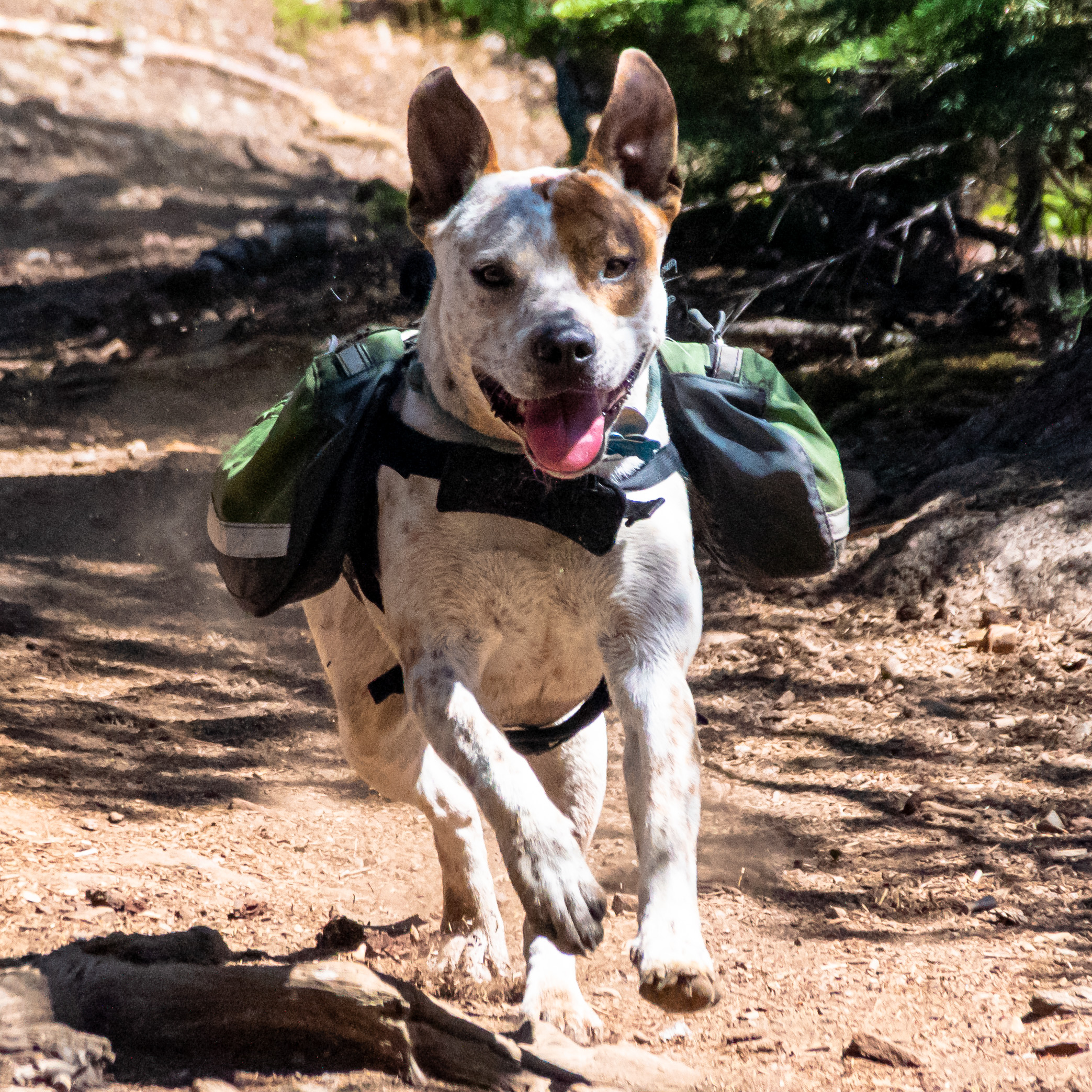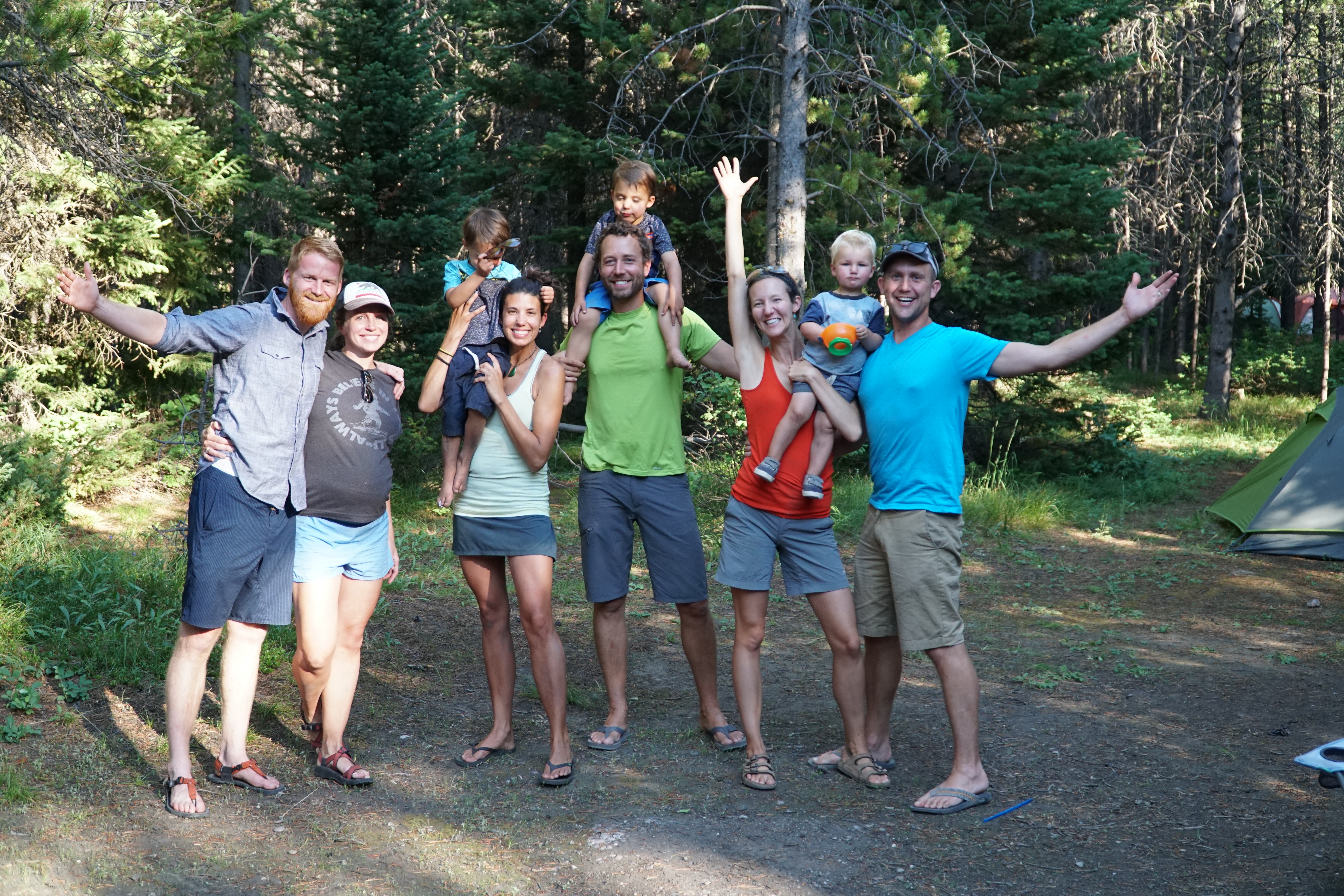Being a Travel PT With a Dog
The Ridiculously Comprehensive Guide
Traveling with your pooch is a wonderful experience. There is just something about being able to share adventures with your four-legged friend that enriches the experience. Maybe it is their perpetual stoke or the night time cuddles, but taking your life on the road – your whole life – wouldn’t be as full without them. Being a travel PT is great, but being a travel PT with a dog is even better! In this article we will go over all of the details, lessons, and tips that we have discovered along our journey as travel PTs.
As many of you are likely aware, we have been traveling with one or two dogs for our entire travel career. Initially starting out with our moody heeler-Aussie mix Layla, and adding the rambunctious heeler-pit mix Cayenne a couple of years later. Both dogs are rescue pups, approximately 55 lbs and have been incredible additions, each bringing her own character and personality to our growing family. While it is easy to talk about the all of the positives, there have been some downsides as well. We will be sure to go over those as well in the following article.

On the Road: In transit
Traveling across the country with your dog can seem like a daunting task, but really it is no more difficult than making the expedition on your own. Obviously, there are a few considerations to be made. First, you need to be sure your pup can handle being in the car for extended periods of time. Car sickness or an ill-trained bladder can make your road trip nearly unbearable and need to be remedied before you venture too far from your home. Most of the time you will already be aware of these issues before you make the big move. Sometimes however, that is not always the case.
*Skip this story if your have a weak stomach*
We first got Cayenne while trying to go perm in our home town in Colorado. Unfortunately things did not work out well there and, to make a long story short, Ellen took a job 7 hours away on the other side of the state from us (the closest job she could find in a pinch). During that contract I had a series of weekend meetings that would be held in Denver, 5 hours away from me. Being only 2.5hrs from where Ellen was working, we made plans to meet up there so we could spend weekends together. In my hurried excitement to see her, I fed the dogs and loaded them in the backseat of the truck (we used this dog sling to protect the upholstery) and hit the road immediately after work late on a snowy Friday night, eager to make it through the mountains safely and quickly.
At first the drive was great. Snoozing pups and clear roads made for smooth cruising for the first hour and a half. Then we hit the switchbacks ascending, then descending, Wolf Creek Pass. I immediately regretted feeding Cayenne before the ride. The pungent scent of partially digested dog food came in waves. Each time corresponding to another up-chuck. Being a dog, she would get sick, re-consume it, then get sick again. Each time further liquifying her stomach contents and turning her pile of dog food remnants into a sloshy puddle that went EVERYWHERE! You are probably asking yourself why I didn’t get out and clean it up after the first time. Oh trust me, I would have, but on a snow covered mountain pass, at night, there are few safe options to pull over and scoop out pet puke.
Lesson learned: Be ware of curvy roads and altitude.
Taking your pup out to pee every time you fill up for gas is an easy way not to be a neglectful dog parent. Keep in mind that when in a new place it may take your dog longer to find “that perfect pee spot” and relieve themselves.There is no point in rushing them, trust me, we have tried… (Layla once held it for 31hrs, not out of need, but stubbornness)

Second, plan for as much exercise as you can budget for your dog. A tired dog is a good dog. Even our seasoned traveler Layla gets stir crazy after a day or two on the road. She will become a nuisance in the back seat, nosing our ears or licking the backs of our heads in an attempt to get our attention to play.
We try to find at least one dog park or trail per day where the girls can get out and romp a bit (this also helps with our own sanity). alltrails.com or even simply using Google Maps can be super helpful to find a little open space to stretch your human and dog legs.
-Most medium sized towns have at least one dog park these days.
-We will discuss finding trails more later so keep reading!
Third, some states and cities have funny rules about dogs in cars. Portland, OR has a strict law against leaving your dog in the car AT ANY TIME. Someone almost called the police on us when, on a 50 degree day, we left Layla in the back of the truck for 10min with the windows half way down… Here are a few links to check out regarding dogs in cars.

On the Road: Accommodations
Finding dog friendly accommodations can be a challenge when traversing less populated areas. The way we see it there are three options:
- Drive through the night – Sleep? Who needs sleep? While this is an option for some of you, others may not be able to safely pull it off. When we are taking one car as a family we often opt to switch drivers and plow onward, but when we have both cars in transit – like when we move to a whole new state – we proceed to options 2 or 3.
- Camping – Once you are west of Denver, CO there is TONS of camping space available for cheap or free. National Forest land is always free camping and you can do so right off of any of the side roads (its not as sketchy as it sounds). Often there are campgrounds along the way for approximately $20/night. We have done this countless times in our travels and highly recommend it. Safe and with bathrooms its much nicer than popping a tent by the side of a dirt road.
- Hotels – Obviously this is the option that most of you will take (we have learned that our love affair with sleeping out of doors is not shared by all). There are quite a few ways to seek out a hotel for the night when on the road. I have listed a few below, but there is one clear stand out in our book: La Quinta Inn – This is by FAR the best hotel chain we have found for traveling with pets. Nation wide pet policy of 2 free pets… of any size! La Quinta is easily our go to when we are on the road and planning on a hotel stay instead of camping. (We do not have any affiliate relationship with La Quinta. We just love them.)
Here are a few other options for finding housing while driving with a pup:
Expedia.com – Most of the hotel descriptions include pet fees and weight limits. It is always good to double check by calling the front office, but overall we have found it to be pretty quick and easy to do while on the road.
Aggregating sites:
While in theory these sites should be incredible resources, the honest truth is that most of the time they are lacking updated information and have disclaimers that you need to contact any hotels or locations yourself to confirm that they are still pet friendly. I have included a few but we do not frequent these sites and instead opt for doing our own research (which tends to be just as fast and more accurate).
dogfriendly.com – Likely the best aggregating site out there though the site could looks a bit outdated. Good descriptions of hotels and their location
BringFido.com – hotels, restaurants, hiking, etc.
tripswithpets.com – hotels mainly, some flight info.

Housing
For the sake of keeping this article a somewhat reasonable length I will not go into all of the details about finding and acquiring housing as a traveler. We have done that Here already and even have a free e-book on the topic. I will only go into the finer points of housing specifically with a pooch in tow.
Weight – Depending on the state, apartment complexes and rental units will likely have weight restrictions on your pet. Here in the Bay Area of California it seems to be 40 lbs. but in Washington anything over 25 lbs was considered a “Large Breed.” We have found that these limits are rather arbitrary and vary widely from place to place. Be sure you call ahead or confirm this online prior to renting.
Breed Restrictions – Unfortunately crappy dog owners have messed this up for all of us. There are common breeds such as: Dobermans, Rotweillers, German Shepherds, and Pit Bulls that are considered risky. Try not to blame the landlord if your dog is excluded, from our research it seems that this is often dictated by the facilities insurance policy, not the landlords in particular.
Number of pets – 0-2 is the most common for apartments.

Pet Fees – Seriously the biggest bummer we have about traveling with our girls is all of the pet fees or “pet rent” that we pay. It is nearly inevitable that you will have to pay more for your dog to live with you (a few exceptions listed below in Special Considerations). Here are a few things to be on the look out for:
Pet Fee vs. Pet Deposit: At our current apartment we had to pay a huge amount upfront for our dogs. Initially taken aback by the amount, we were pleased to discover that this is a deposit and we will receive it ALL back upon move out. Knowing that our girls are well behaved assuaged our fears and made stomaching the hefty sum easier. In other apartments we have been hit with less significant up front payments, but these are frequently fees and we cannot get the money back upon move out.
Pet Cleaning Fees: Some apartments will charge a one time or even a recurring pet cleaning fee. Be sure you look over your lease carefully to identify these, then be sure that these services are actually being provided. We were once paying monthly for “flea treatment” but when we went to move out they tried to require us to pay for special flea spray on the carpet. Ellen did some nifty maneuvering to get us out of that one.

Apartment size/location considerations – Our girls require a TON of exercise, but during the day are about as lazy as you could imagine. When we look for an apartment we no longer require a back yard for them to play in. We did that once, and they just laid around and snoozed or begged to come back in if someone was around. We simply need a nearby patch of grass for doing their business. Of more importance for our girls is the proximity to a dog park or to trails. Doing a good Google Maps search of the area before signing a lease is essential for us.
Tip: Build a reference list for you dogs good behavior and house training. Also, include any obedience class certificates.

Veterinary Needs
Unfortunately we have had some scary health issues with our pups. Thank goodness for good veterinarians nearby! The one lesson that we had to learn the hard way is the importance in establishing a veterinarian in your area if you plan on being there for a while.
Christmas morning a few years ago Cayenne woke up with an upset stomach. We had been camping in Big Sur, California and assumed that she had eaten something gross and it would pass. A few hours later she began shaking with pain. She would only deteriorate from there as we drove back home. Because we did not have a veterinarian we were forced to go to a 24hr Vet Emergency center… dollars seemingly fly out of your pockets once you walk into those places. After an exploratory abdominal surgery and three fourths of a tennis ball later she was feeling better and sent back home with us. Fortunately, Cayenne was able to get the care she needed and was back in action within the week, though our pocketbooks would be hurting for months to come.

There are some good nationwide vet networks that claim to expedite care between sites should you move locations. We have used VCA before with good results, but have not been in another location where they are to see how the continuity of care is.
VCA Hospitals – 43 states
Pet Vet Care Centers – 27 states
Fleas and Ticks
The idea of waking up to the tickling sensation of a tick climbing up your arm or up the back of your neck while you are driving in the car gives me the creepy-crawlies just thinking about it (both of these things have happened to us). Having pets that explore the wilderness as much as we do inevitably leads to finding ticks on their bellies or behind their ears. Properly treating your dogs based on the flea and tick season in your area is essential.
With the rapid spread of Lymes disease across our country it is very important that you treat your dog for fleas and ticks. The assumption that Deer ticks are only in the North East is no longer true. Spreading all of the way across the South and up the California Coast, the dangerous ticks are nearly everywhere. While Deer ticks are not a danger to your dog, they most definitely are for you. Protect your pup and you’ll help protect yourself! The AKC has a great map showing you when flea and tick season is in your area. Check it out Here.
Pet Insurance
Many travel agencies offer pet insurance as and option. Be sure that you crunch the numbers to find out if it is worth the expected cost for you and your pup. After Cayenne’s ordeal we looked back at the bills and the benefits of having pet coverage. Even with the hefty cost of the surgery and imaging we would have paid $65 MORE had we had the pet insurance… though it would have been spread out over the year in premiums making the total bill more palatable.
There are pet hospital companies such as Banfield Pet Hospital that offers its’ own pet plan for use at only their facilities. Depending on your dogs health this is an option for some. Under the
Essential Wellness Plan our dogs would be $37.95/mo, covering 2 physicals, routine vaccinations, deworming treatments, and unlimited office visits. Not a bad deal considering all of the services provided (they claim you would save 41% of full price should you take advantage of all services).

Dog Adventures
Hiking with dogs
There are countless sites claiming “10 tips for hiking with your dog” or “7 essentials for hiking with your dog” – 90% of these are useless. Here is what you need to know:
Be sure your dog is under control. Whether by voice or by leash you need to have good recall from your dog as you never can be quite sure what you will come upon on the trail.
Unless you take your pup to the dog park for hours a day, your dog is likely only slightly more fit than you are. If the hike is going to be hot and hard for you, it will also be hot and hard for your dog. Bring adequate water (unless you are 100% sure there is an active water source on the hike – droughts in CA and CO have bit us in the butt before). Dogs, like most fur covered mammals, are actually pretty bad a shedding excess heat. On some of our big hikes into the mountains, the dropping temps at higher altitude is like a fountain of youth for our girls. Panting and ducking for shade down low, they lose their dog minds once they hit snow line, romping and sprinting around like the day just started.
Another consideration is your pups foot pad thickness. Many pampered pooches only see rough rocky trails a few times a year. Their little foot pads are not built to be indestructible unless they are consistently used in a way that necessitates it. Just like your hands build calluses from working with tools or lifting heavy weights, so too will your dogs pads build up a tolerance to the abrasive impact of gnarly trails. If you do not have time to let your dogs paws toughen up there are some great paw covers available (click linked image).
This also applies to severe cold and snow. If your dog has hair between the pads often ice collects and creates painful wedges. And if you are super adventurous and out in the super cold, hoar frost can be like glass to a dogs paws (if you are braving weather that cold you will know what hoar frost is so I wont explain here.)
Also, teaching your dog to drink out of a hydration pack hose is super clutch on a long dry trail!

Parks
Park pet friendliness varies depending on the state and type of park you are planning on visiting. Below is a list of guidelines for each type. Be sure you check your specific park as there are frequent exceptions:
- National Parks: Dogs only on leash on paved paths and in campgrounds.
- State Parks: Largely not dog friendly but variances between states are big.
- Regional Parks: Common in California these are unbelievable parks! Officially dogs on leash only but once your 1/4 mi in everyone lets the pups romp. Great places.
- Dog Parks: Off Leash…Duh!
- National Forest: Off Leash!
- National Wildlife Preserve: Mostly no dogs, but some allow for them on leash in designated areas.
- Beaches: Vary beach to beach and state to state depending on delicate wild life areas.

Backpacking with dogs 

We are firm believers in having our dogs carry their own food. Dog packs can fit 3-4 days worth of dry food for our 55 lbs dogs. The best part is that as their pack empties out you can stash some of your lighter gear (dirty laundry, baby diapers, etc) into their packs to take the load off your shoulders.

Air Travel
We have never traveled via air with our dogs so Im going to defer to two resources that I felt were helpful:
Air Travel by Merck Veterinary Manual
Alaska/Canada
Driving through Canada on our way to a contract in Alaska was by far one of our most memorable experiences as travelers. We were super thankful that we bought the Milepost guide book, the bible for anyone driving through Canada, and followed its advice. Essentially a vet health certificate needs to be signed by your vet along with vaccination records and some sort of identification describing your dog. Pretty basic stuff. Here is a helpful link.

Hawaii
Traveling into Hawaii with your dog will require considerable planning, but it is getting easier. With changes made at the end of August 2018 the Hawaii Department of Agriculture has greatly decreased the mandatory waiting period before traveling to the islands. There is an extensive series of vaccinations and tests that need to be completed. This website is a super helpful resource and needs to be followed to the letter.
Travel Without Dogs
So when leaving town for a while without your dog there are three options for pet sitters. One, a friend or neighbor who is willing to take on the challenge of your frisky pup. Two, hiring someone to do come to your home and dog sit or dog walk. We have found that the site rover.com is the best for finding dog walkers and sitters. We have had many positive experiences on the site and highly recommend it. The third option is a doggy boarding or daycare center. These can be a bit more difficult to find and often require a meet-and-greet before you finally drop them off. Be careful to tour facilities and make sure you are comfortable with your dog staying there. Some of these can be shady looking and poorly run.
Special Considerations
One of the things we get asked a lot about is getting our dogs “certified.” However being “certified” has many different meanings and requirements. Being an Emotional Support dog or Service dog will allow you to bypass any dog fees at your apartment which is nice, but that is where the similarities end.
Here is a quick summary of the certifications:
- Service dog (Psychiatric services dogs)- for debilitating medical conditions and have special training and can perform tasks – ADA protected.
- Emotional support dog – Not to be confused with a psychiatric service dog. – Benefits for rent under Fair Housing Act – ADA excluded – no public access rights meaning you cannot take them into public areas that are not open to all dogs. There are also lots of opportunistic websites providing certification and useless “equipment” for your emotional support dog.
- Therapy dogs – go to hospitals and nursing homes – also excluded from ADA
Nice video summary: https://www.youtube.com/watch?v=4C459sQwrAo
Air Carrier Access Act: allows dogs in the cabin but may be required to show documentation of specific emotional disorder. However as of May 2018 this ruling added wording that may be interpreted as a excluding emotional support dogs while still allowing for the more highly trained psychiatric service dogs… its kind of confusing.
The Downsides of Being a Travel PT with a Dog
- Anyone will watch one dog but it is hard to find someone who will watch two.
- City adventures are more difficult and require planning or pre-exercising your pups before you leave for the big city.
- Higher rent in most situations.
By: Stephen Stockhausen PT, DPT, OCS








